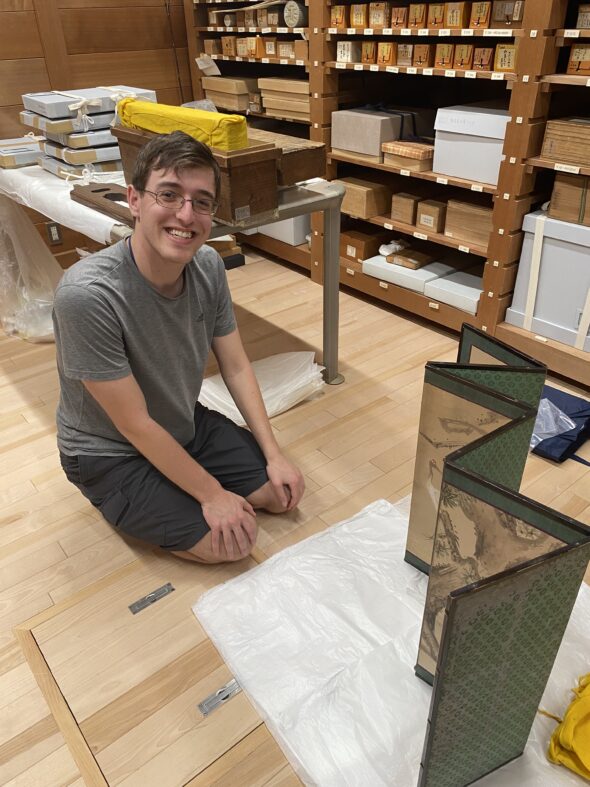
My activity was volunteering at the Doshisha University Historical Editorial Office and History Archival Center. I got to participate in and learn about numerous tasks the university carries out in order to preserve and promote its history. One week, I was helping arrange an exhibition for the university, and another, I was handling precious historical objects that belonged to famous figures in Japanese history. It was a truly unique experience to see Japanese historical conservation from the inside out, and to meet and talk with other people fascinated by history, whose perspective on history was necessarily shaped by growing up in a culture and historical environment wildly different from mine. I believe that any experience as a study abroad student has contact and interaction with new perspectives as a primary objective, and this historical-related activity was perfect for that – indeed, history is all about perspective! The volunteer activity felt mostly very informal, so one could really choose to do what was personally interesting if one spoke up – though there were certain moments of sudden formality, so one could get a taste of a whole gamut of types of experiences. So be flexible enough to go with the flow and enjoy every moment for how unique it is!
「Brown University」カテゴリーアーカイブ
Jacqueline Zou: Kyoto Animal Shelter
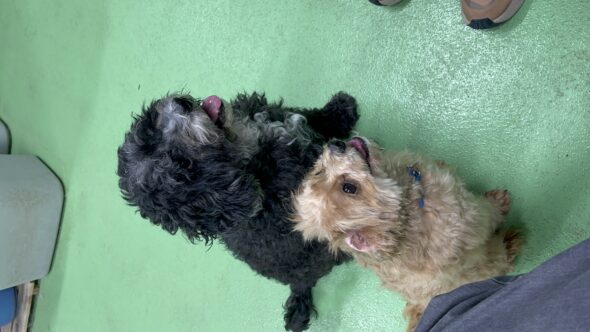
My CIP was to volunteer at the Kyoto Animal Shelter 動物愛護センター. Our weekly session usually involves walking the dogs and cleaning the dog pens and cat pens. I really enjoyed walking the dogs—the best part of it is that, as we gradually gained the dogs’ trust, we got to know the name and personality of every dog and truly became friends with them. We were even able to teach them how to listen to instructions to sit down. The workers there are also extremely friendly and encouraging.
For future students looking into volunteering at the shelter, it does require some tough mentality to clean up the dog pens at times because it can get very nasty, but I think being able to spend time with these adorable animals outweighs the tediousness of work.
Kyra Douglass: Tea Ceremony
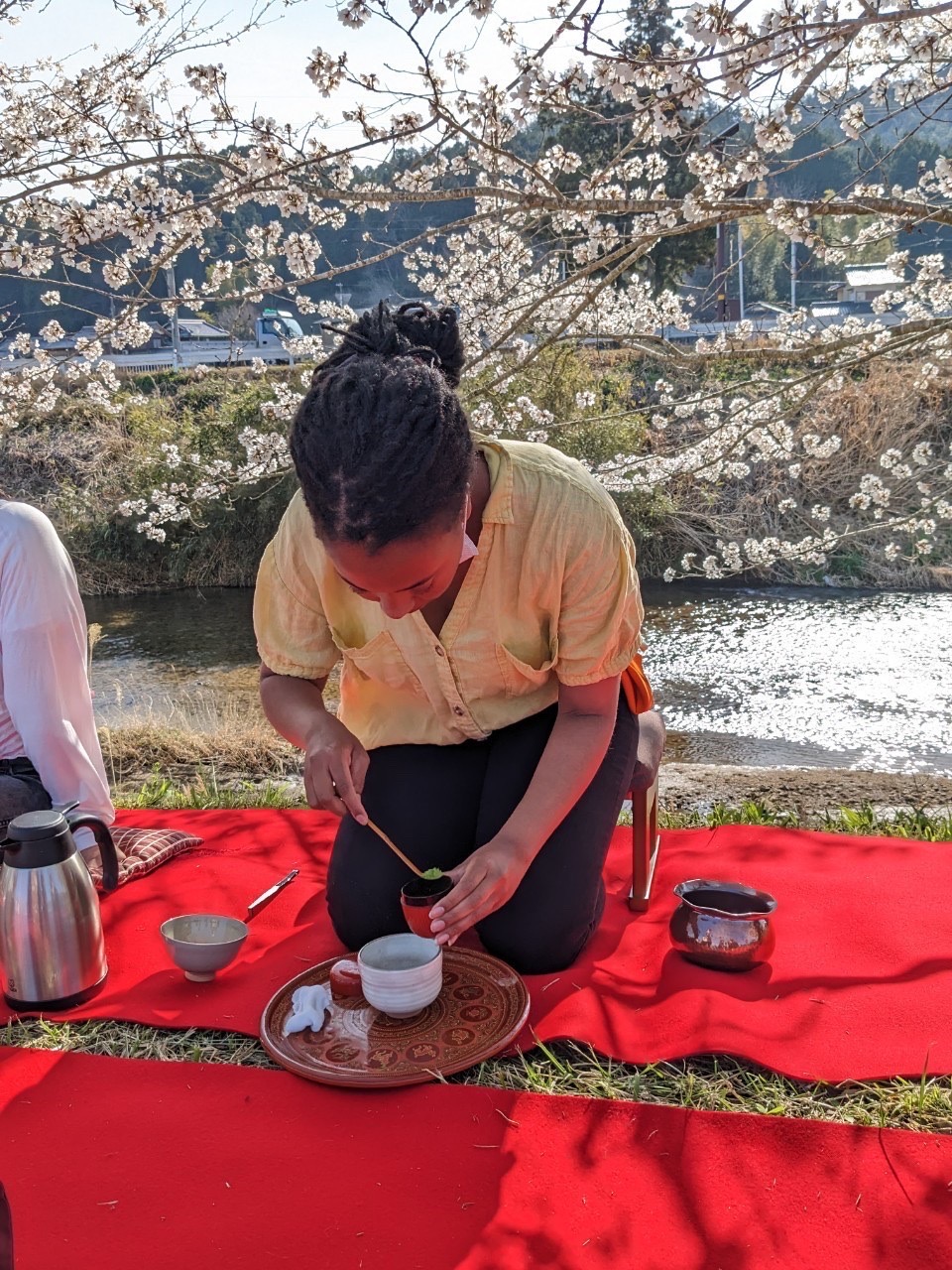
For my CIP this semester, I took tea ceremony lessons. When I came to Japan for the first time in 2018, I had the opportunity to go to a rural high school’s tea ceremony club. Admittedly, I didn’t really like matcha at the time, so I was having a hard time drinking it then. However, between then and the start of this last semester, I’ve come to love matcha, so deciding to take tea ceremony lessons was a no-brainer for me. Our first day was more of a demonstration and less of a lesson. It was still winter at that point, so the more suburban/semi-rural area that we traveled to for the demo was even more beautiful because of the snow on the ground. The windy streets surrounded by trees and mountains were like nothing I had ever seen. When we finally found the ryokan we would have classes in, we met Fujimura Sensei. She was wearing a kimono, which fit right in with the general traditional vibe of the small tatami room where our classes would be held.
I was extremely nervous at that point. Everything in the room was so perfect, intentional, and unfamiliar to me, and I was afraid that I was somehow going to break something. Since this was very early into the semester, this had become a very common feeling since arriving in Japan: being generally uncomfortable. As Fujimura Sensei was doing the demonstration, I was so impressed by not only the intricacy of the ritual but how graceful and sure she was in each of her movements. I was a little intimidated at first, thinking there was no way I would be able to come close to that level. Even so, Fujimura Sensei was extremely kind, and I would later find out, just as patient and encouraging. Our lessons were completely in Japanese, and when I would struggle with the language, she would use hand movements to help me understand. Also, Connie Situ and Geetanjali Gandhe, the two other KCJS students who were taking the lessons with me, were beyond helpful when it came to helping me understand some of the Japanese instructions. Through their help and Sensei’s teaching style and overall friendliness, I was able to let go of the need to be perfect, and this made me so much more confident and, ultimately, have a lot more fun. This is something I want to carry with me after the end of the program because it can open more doors for me because I am less afraid of failure and am more comfortable with being uncomfortable.
My CIP was also special because Fujimura Sensei went out of her way to teach us about the cultural history of Kyoto and Japan at large. To celebrate White Day, she prepared a multiple-course meal for us and explained the meaning and traditions behind each dish. It was delicious and I was really happy to participate in this holiday for the first time. Later in the semester during sakura season, we did an ochakai, or formal tea ceremony, at Heian Jingu, and later drove out to the countryside to do our own tea ceremony. It was such a beautiful experience, and I’m grateful to Fujimura Sensei for putting it all together. This semester was definitely full of awkward moments and small failures, but because of that, I feel like I am a more confident person than I was at the start.
Lola Simon: Karakami Papermaking
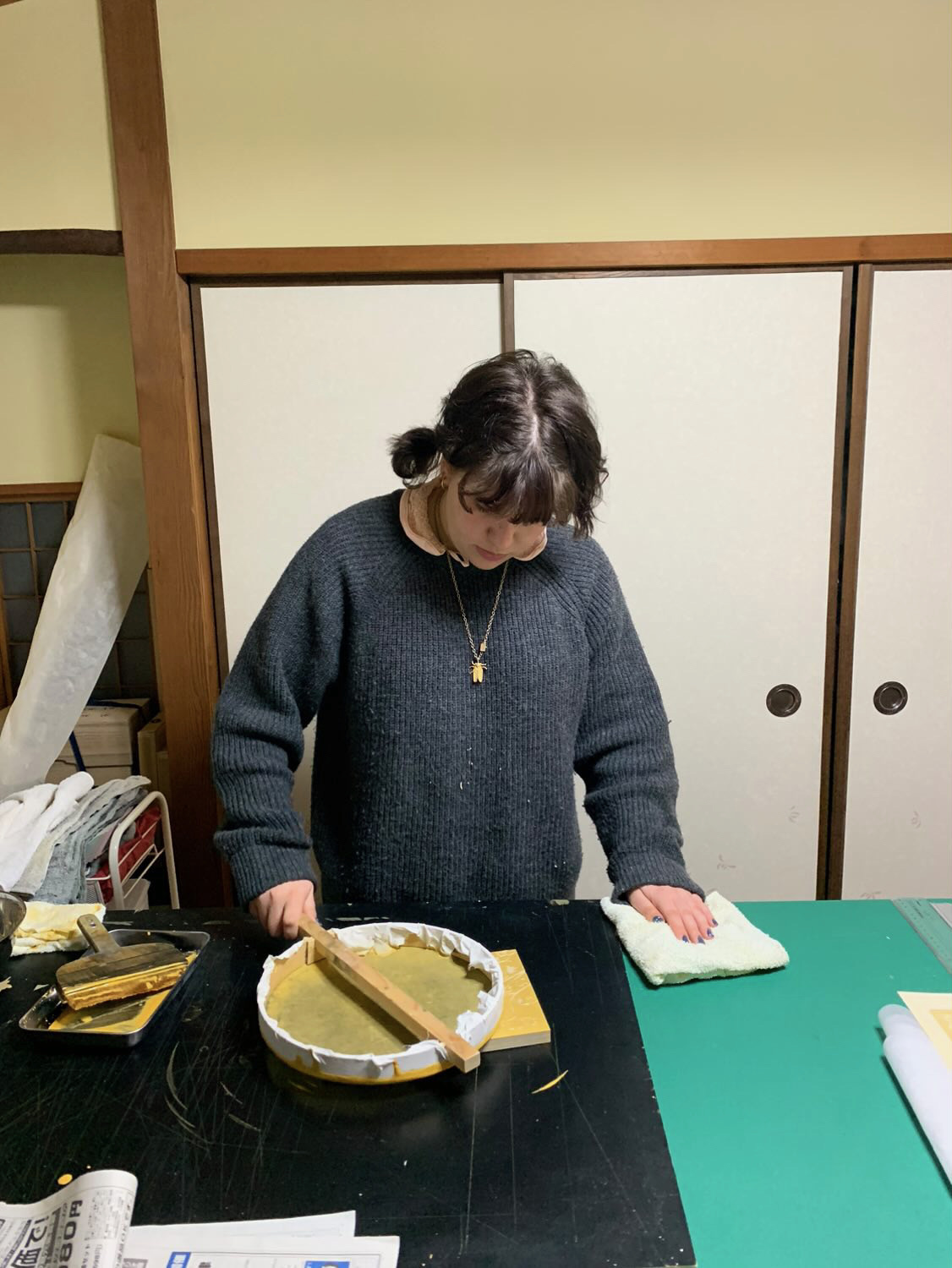 This semester, I studied a form of traditional decorative papermaking known as karakami with Sugawara Fumiha, a karakami artisan based in Kyoto. Professor Melissa Rinne, who I took the class Kyoto Artisans and their Worlds with, connected me to Sugawara-sensei, who graciously offered to work with me for my CIP.
This semester, I studied a form of traditional decorative papermaking known as karakami with Sugawara Fumiha, a karakami artisan based in Kyoto. Professor Melissa Rinne, who I took the class Kyoto Artisans and their Worlds with, connected me to Sugawara-sensei, who graciously offered to work with me for my CIP.
I study visual art at Brown with a particular focus on printmaking. I hoped to learn something related to printmaking or papermaking for my CIP. Karakami is at the intersection of both! It involves using carved wood blocks to create patterned papers that are typically used to decorate fusuma sliding doors or shoji screens. Karakami came to Japan from Tang Dynasty China during the 8th century, so it is an extremely old art form that still maintains traditional techniques. This involves mixing pigments using mica, a type of crystal found in granite, with gofun, a white pigment made from ground seashells, and funori, a type of glue that comes from dried and boiled seaweed. The ink is brushed onto a special sieve made of gauze, which is then pressed directly onto the woodblock to transfer the ink to the carving. Finally, a piece of paper is placed onto the block, and, using pressure from your palms, the design is transferred onto the paper.
I was able to create and carve my own karakami woodblock designs of bleeding heart flowers and blueberries. I learned how to mix inks, print the blocks, and cut and glue together the papers in order to create a continuous pattern. I even got to make my own karakami panel which I can hang up in my room.
This experience was one of the most meaningful opportunities in my study of both art and Japanese. I learned so much from Sugawara-sensei, who was an extremely kind, generous, and patient teacher. Over the course of the lessons, I grew more and more comfortable talking to Sugawara-sensei in Japanese and was able to form a life-long connection. I was able to learn an art form that I never could have studied without my time at KCJS, and will be forever grateful for this experience.
Advice to future students: if you have a particular interest you hope to pursue in Kyoto, go for it, even if it seems like something that could be difficult to find! I never thought I’d be able to study printmaking with an artisan in Kyoto, yet alone something as special as karakami. However, after talking to KCJS staff and professors about my interests in printmaking, I was able to be connected with Sugawara-sensei, who, despite having never taught lessons before, enthusiastically agreed to teach me. The KCJS program is incredibly supportive and well-connected to Kyoto and may be able to find you opportunities you’d never expect.
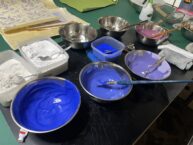
Ink mixing!
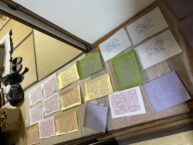
Karakami paper laid out to dry.
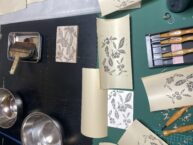
Carving a design.
Bryce Okihiro: Volunteering at Hiroto Yoshida's Sweet Potato Farm and Toshiharu Nagao's Shop in Miyama

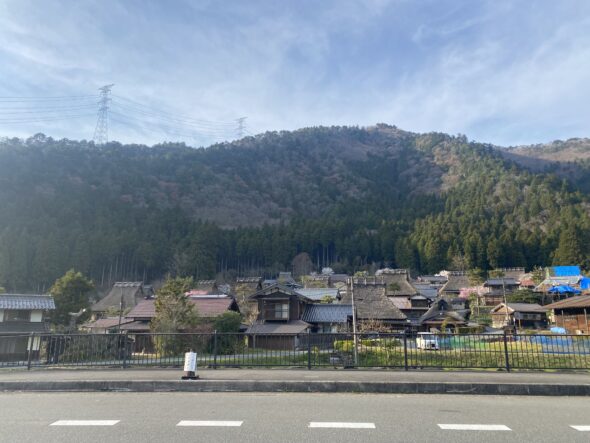

The CIP I undertook this semester involved working at Hiroto Yoshida’s sweet potato farm (e.g. constructing fencing, tilling the soil, planting sweet potato shoots) and assisting a local shop owner Toshiharu Nagao (e.g. packaging sweet potato products, learning about roasting sweet potatoes) in a rural area called Miyama in northern Kyoto. Through the experience, I learned about the processes and challenges of farming and having a business in the countryside and the methods through which young people are trying to revitalize Japan’s declining town areas.
The experience was a once-in-a-lifetime opportunity, not merely because I had the chance to explore a region of Kyoto not so commonly visited, but more importantly, because of the transparent conversations I had with locals and the perspective-altering experiences I had whilst working on the farm and interacting with people in the community!
I would definitely recommend this CIP to students who have a passion for farming and a deep interest in the challenges facing Japan’s rural areas. The time and labor commitment to this CIP is intensive (one volunteering session will run from morning to evening (it takes two hours to commute to Miyama and another two hours to come back!)), so if you aren’t genuinely interested in experiencing and learning about life in Miyama, I suggest not even thinking about doing this CIP. But if you do have a genuine passion for farming and learning about rural life in Japan (as well as learning Japanese since most residents in Miyama don’t speak much English), this CIP will undoubtedly be an invaluable and extremely worthwhile experience, and perhaps even life-changing as well!
Zackary Entwistle: Shakuhachi
I learned how to play shakuhachi for my CIP. Every Thursday I received private lessons from Kawamiya-san for around two hours where I was taught the fundamentals of the instrument, and every Tuesday I put what I learned at my lesson into context by playing with Iwazaki-sensei’s ensemble of koto, shamisen, and shakuhachi players. These lessons and rehearsals culminated with two performances, one where I played a duet with my private lesson teacher and another where I performed a couple pieces with the larger ensemble.
I adored my experience learning shakuhachi here in Kyoto. I’ll cherish not only my newly acquired (but still extremely rudimentary) ability to play this instrument I had never even heard in person before coming to this country, but also the memories I made from practicing at rehearsals, getting dinner with my teachers, and going to parties together after the performances. Of course there were also times when I struggled, as hardship is inherent to learning a new instrument, and especially finding time to practice at home in addition to scheduled practices twice a week was challenging to do during a short study abroad experience. But overall, I couldn’t have dreamed of a cooler way to interact authentically with Japanese people and learn about traditional Japanese culture, improving my language skills along the way too.
For any incoming students thinking of learning a new instrument as your CIP, just make sure you’re okay with the sacrifices first. Your time abroad is short and an activity that requires diligent practice like this will drain any freetime left in your already extremely packed study abroad schedule; my time spent on shakuhachi-related activities would sum to more than 10 hours most weeks. I was happy to let shakuhachi be such a big part of my study abroad experience, but you should be mindful of the commitments you’re making before you make them.
(See the full performance here: youtu.be/7RdvqViO6cI)
Christopher Avalos: Tea Ceremony Lessons
For my CIP activity, I took tea ceremony classes at Kyoto Wabichakai わび茶会(http://www.kyoto-wabichakai.info/). They took place once a week for around 2 hours. Even though this semester abroad was unfortunately cut short, I was able to take four lessons and learned a great deal in that time. I have always really liked Japanese tea and have seen videos about tea ceremony, but I still didn’t really know much about it. With the help of Yamaoka sensei, I found Wabichakai.
For my very first lesson, I mostly observed my sensei as she performed the tea ceremony for me, which involved multiple rituals, preparing and serving the tea, and serving wagashi, or a traditional Japanese sweet. The wagashi was one of my favorite parts of my tea ceremony experience, as the sweets were not only delicious, but they usually held some meaning. For example, one of the lesson’s wagashi was a plum blossom shaped mochi treat, which signified the winter season. I was also fascinated by the ritualistic nature of the entire ceremony. Specifically, everything was done precisely and a specific number of times. During the ceremony, my sensei also explained to me the history of tea ceremony in Japan. Although the vocabulary used was difficult at first, it got easier as time went on through the use of flash cards.
Subsequent lessons saw me more active during the lesson. My sensei taught me how to properly hold a tea bowl and how to drink the tea. Everything had to be done precisely and cleanly, especially when eating and drinking. Moreover, another one of my favorite parts about my experience was the field trip we made to Kitano Tenmangu shrine. The time we went, they had a plum blossom tree field for plum blossom viewing. Not only were the plum blossom trees beautiful, we also got some plum tea. My sensei also explained the history of the temple to me, as she is also well-versed in Kyoto history.
I really enjoyed the one on one nature of the lessons, as it allowed me to really build a relationship with my sensei. Not only did we perform the tea ceremony, but we also learned about each other as well. She told me about her experiences living in San Diego when she was younger and about her daughter. We also talked about my other classes, my family back home, and about my homestay family and experience. Even though I only had a few lessons with her, I feel like we were able to build a relationship that will hopefully last for years to come.
Despite the craziness of the past couple months, my CIP experience was a worthwhile one, and I plan on taking another lesson when I return to Japan in the future. I am grateful for the time I was able to take lessons with my sensei, and I look forward to seeing her again the future.
Sofija Podvisocka: Fencing
One of the conditions depending on which I decided to study abroad at Doshisha University was the presence of a fencing team, since I needed a space to practice in order to rejoin Brown’s team upon my return. Doshisha’s fencing team operates with a system very different from the one I’m used to, due to the absence of a coach and the dependence on small groups to schedule their own practices, which included usually a warm-up and sparring, with a few days where we would give each other individual lessons. I would meet with the women’s epee team anywhere from two to four times a week, depending on everyone’s availability.
Practicing with the Doshisha fencing team led me to better understand Japanese cultures in terms of the senpai/kouhai system, but also the progression from using respectful forms to casual speech as we got closer. Furthermore, since I was the youngest of the group, although I had the most experience with fencing, I was given very little responsibility in terms of practices. However, as time went on and the boundary between me and the upperclassmen began to dissipate, I was allowed more say in what the practices entailed, and could even lead some of our drills.
That being said, Doshisha’s fencing team reminded me in many ways of my own. No matter the differences in speech between Japanese and English, the struggles of the student-athlete remain the same. Between balancing classes and practices, making time to focus on this extracurricular, and the comradery of the team dynamic, I felt very much immersed in the same society as I was back home.
For future KCJS students thinking about their CIP going into their study abroad experience, my main piece of advice would be to choose not based on the subject of the CIP entirely, but also based on the community you would be involving yourself in. Focus on building relationships throughout the semester just as you would back home, even though there’s an expiration date hovering in your mind you can’t always ignore. The CIP itself might be temporary, but what you learn from it will remain ever-present.
Sunny Snell: Volunteering at Preschool
For my CIP, I volunteered with Mitsuba Preschool twice a week as an English teacher and more general participant in daily activities. On Mondays, I joined the preschool for lunchtime, eating and playing outside, and on Thursdays I would come during after-hours, which was mainly indoor play.
Mitsuba is organized into three classes oldest to youngest: yurigumi (lily class, kindergarten-age), baragumi (rose class, pre-kindergarten), and momogumi (peach class, very pre-kindergarten). Although this was explained to me early on, it took a while to sink in. Similarly, there were other elements to the preschool, such as when and where we clean up, when it is appropriate to play, and how to dispose of a plastic bento box, that it felt like I struggled to learn. In general, I felt a lot of concern at first about fitting in and figuring out where I should be at any given time. However, the sensei’s and children were welcoming, it wasn’t long before I found myself more comfortable and invested, albeit not the most aware of every detail. Despite my lower level in the language, through smaller attempts at memorizing names or bringing proper supplies, I did my best to show the principal and teachers how much I wanted to be there, and they were hugely supportive. I also began to notice really interesting points about the preschool. For example, after playtime each day (which included activities like knitting, coloring, or construction using toys like Legos), the teachers would call up a few students to show the others what they had made. This was a fun way to see playtime being used for more specifically creative purposes, and I could tell the students loved the chance to see their effort validated. And the items that the students created truly were impressive: I watched a boy make a fully functioning (if not motorized) merry-go-round from a plastic construction-type playset.
Towards the beginning of the semester, I did activities like reading and singing in English, even singing “Let it Go” karaoke-style for all the kids during after-hours playtime. While that was a lot of fun and I hope the students enjoyed it, the most rewarding part of this semester was probably getting to know one particular student. During playtime, I noticed a student whose family more recently immigrated to Japan spent more time on the sidelines, so I approached him and we began to play together, most often communicating through gestures since neither of us could speak to each other in Japanese that well, let alone the other’s native language. Eventually he started to open up and seek me out, and I had the opportunity to see firsthand his work to adjust to the pace of the preschool. Just this week I spoke with another teacher about how much he has worked to learn Japanese: when I first arrived he was hardly speaking at all, but last week I watched him get through whole sentences. Being close enough to watch him improve alone made me feel the time I invested in the preschool was worthwhile.
Overall, I enjoyed the time I spent at Mitsuba and feel very grateful to have had the opportunity to get so uniquely involved in the community immediately surrounding Doshisha. If there is anything I have taken from the experience, it is gratefulness for the warm welcome of the teachers and students, and excitement for the future of the preschool, even if I cannot be there for it.
Nicholas Rasetti: Tennis
For my CIP, I’ve been playing tennis at the Saiin Park Tennis Courts with a local recreational program. Every Tuesday, Ben Bellick and I show up at 6PM and get to practice honing our tennis skills, both with each other, with Japanese, and under the guidance of the people running the program. Even in the short time I’ve been playing for since coming here, I can already see a lot of improvement in my game. On top of that, it’s a great way to blow off stress and relax without going out and spending too much money.
Although not particularly a Japanese activity in and of itself, I feel like tennis is a good window through which many aspects of Japanese culture and people can be seen. For example, one of my most common observations throughout my time on the courts was the willingness of the Japanese to lend a helping hand whenever you need it. They’ll gladly take time out of their own development to help you by explaining how you can improve your form or showing you what the right method is. Even with the language barrier, they’ve really done their best and I’ve learned a lot as a result. They have no obligation to help me in that way, but they’re always willing to, and for that I’m extremely grateful.
In addition to a willingness to help whenever I might need it, they’re also very encouraging and supportive. Anytime I might whiff a ball or make an error, they’re quick to jump in and tell me not to worry about it, or “Don’t mind!”. While this might not seem like much, when you’re trying your best to get back into a sport you haven’t played in a long time and are making a lot of errors, it can make all the difference. It’s much easier to laugh off an error along with everyone than to feel uncomfortable because you feel like people are silently judging you. Overall, it’s the little things that make it a true pleasure to go out and play tennis with the friendly Japanese folk down at the Saiin tennis courts.
-Nick Rasetti
